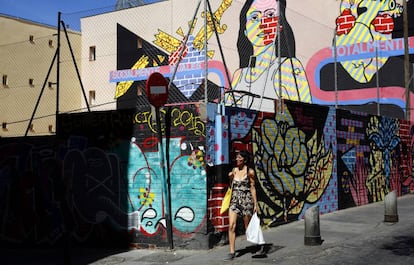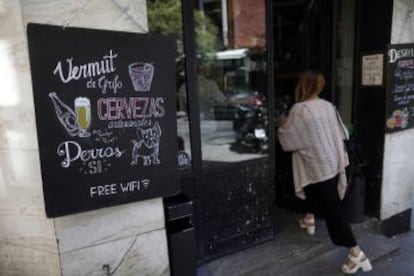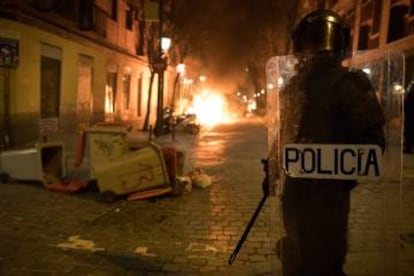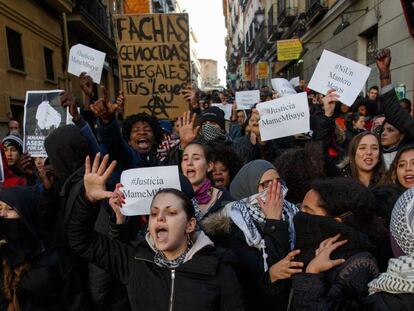Who benefits from Lavapiés’ new “cool” designation?
‘Time Out’ awards top status to Madrid neighborhood, but there are other realities beyond the alternative-chic boutiques and cafés

Hotels, restaurants, bars, theaters, community gardens, vibrant cultural centers... this is just one side of Lavapiés, a Madrid neighborhood that is contained within the larger barrio of Embajadores. The area has just been selected by Time Out as the top choice on its list of “50 Coolest Neighborhoods in the World” after surveying over 15,000 people.
But that funky side coexists with other, more complex realities: gentrification, outdoor binge drinking (known as a botellón in Spanish), bed bug infestations, and a draconian housing market.
When you label a city area as ‘cool,’ it becomes a brand
Javier Gil, sociologist
Two figures illustrate the disparities to be found in Embajadores: it is one of the Madrid areas where the price of housing has seen the sharpest increases (over 21% in the Centro district, which includes Embajadores); it is also the area with the lowest household income – just over €23,800 a year according to city statistics – in the entire so-called “central almond” of Madrid, which comprises seven districts.
Lavapiés runs at two different speeds. The fast lane is on Argumosa street, with its pricey sidewalk cafés and alternative-chic tapas bars. And then there is Oso street, where a Senegalese street vendor died in March of a heart attack. Many of the city’s vendors live in the area, and Mame Mbaye’s death triggered a wave of protests that resulted in torched vehicles and trash containers, and a police operation to restore public order.
“When I arrived in Lavapiés as a student, in the late 1970s, we were all from other parts of Spain,” notes the photographer Marivi Ibarrola, who is showing a selection of images titled De Lavapiés a la Cabeza. The exhibition portrays Lavapiés in the 1980s, when the streets were overrun by drugs and crime. Ibarrola, who still lives here, illustrates through her photography work how “the most conservative customs coexist with avant-garde movements” in Lavapiés.

In the 1990s the neighborhood morphed into a magnet for wholesale establishments that pushed out many of the local mom-and-pop stores. Then, in the 2000s, the low prices and good location drew a wave of immigrants: at one point, the foreign-born population of Lavapiés was 35%. These days, one out of every four residents is originally from Bangladesh, Morocco, Senegal, Italy, France, the United States...
The affordable rent also began attracting actors, movie directors, journalists, non-profits, alternative political movements and squatter groups, all of whom left a mark and created a halo of modernity.
“In Embajadores, and especially in Lavapiés, we are seeing several processes taking place simultaneously: a property bubble, ‘touristification’ and gentrification,” says Javier Gil, a sociologist who specializes in housing and is a member of the Madrid tenant association Sindicato de Inquilinos de Madrid. “The crisis stopped the gentrification process a little, but since 2013 it has been speeding up again. The direct consequences are a transformation of the area, the eviction of part of the original population, and the rising value of land and buildings.”

Ana B., 35, was forced to leave her apartment in the summer of 2017: “I was paying €750 a month and my lease was up for renewal, but my landlord told me to leave. He owns the entire building. A few months earlier my next-door neighbors had left, the owner refurbished the apartment – which is much smaller than mine – and rented it out for €1,100 a month,” she recalls. Ana searched for another place in the same neighborhood, where she had lived for the better part of a decade, but was forced to look elsewhere because of the prohibitive prices.
Gil warns about public aid for building restoration: “If you give out money but fail to add a clause prohibiting the sale of the building for the next 20 years, what you are doing is encouraging speculation,” he says. City officials have just excluded the neighborhood of Embajadores from the designation of “urban regeneration preference area,” which is a requisite to apply for building restoration subsidies. Neighborhood associations were shocked at the decision, because they feel that there is still a vast amount of “old and substandard housing” despite recent improvements.
“When you label a city area as ‘cool,’ it becomes a brand,” says Gil. “It is a symbolic construct that is not tied to objective quality-of-life markers, but which ends up creating a rhetoric that legitimizes urban expulsion. The idea is that since this place really rocks, it is normal that some people should leave. It’s like not everybody has the right to live here.”
English version by Susana Urra.
Tu suscripción se está usando en otro dispositivo
¿Quieres añadir otro usuario a tu suscripción?
Si continúas leyendo en este dispositivo, no se podrá leer en el otro.
FlechaTu suscripción se está usando en otro dispositivo y solo puedes acceder a EL PAÍS desde un dispositivo a la vez.
Si quieres compartir tu cuenta, cambia tu suscripción a la modalidad Premium, así podrás añadir otro usuario. Cada uno accederá con su propia cuenta de email, lo que os permitirá personalizar vuestra experiencia en EL PAÍS.
¿Tienes una suscripción de empresa? Accede aquí para contratar más cuentas.
En el caso de no saber quién está usando tu cuenta, te recomendamos cambiar tu contraseña aquí.
Si decides continuar compartiendo tu cuenta, este mensaje se mostrará en tu dispositivo y en el de la otra persona que está usando tu cuenta de forma indefinida, afectando a tu experiencia de lectura. Puedes consultar aquí los términos y condiciones de la suscripción digital.
More information
Archived In
Últimas noticias
Most viewed
- Alain Aspect, Nobel laureate in physics: ‘Einstein was so smart that he would have had to recognize quantum entanglement’
- Mexico’s missing people crisis casts a shadow over World Cup venue
- Why oil has been at the center of Venezuela-US conflicts for decades
- Trump clarifies who is ultimately in charge in Venezuela: ‘Me’
- Mexico seeks to shore up its defenses following US incursion in Venezuela











































